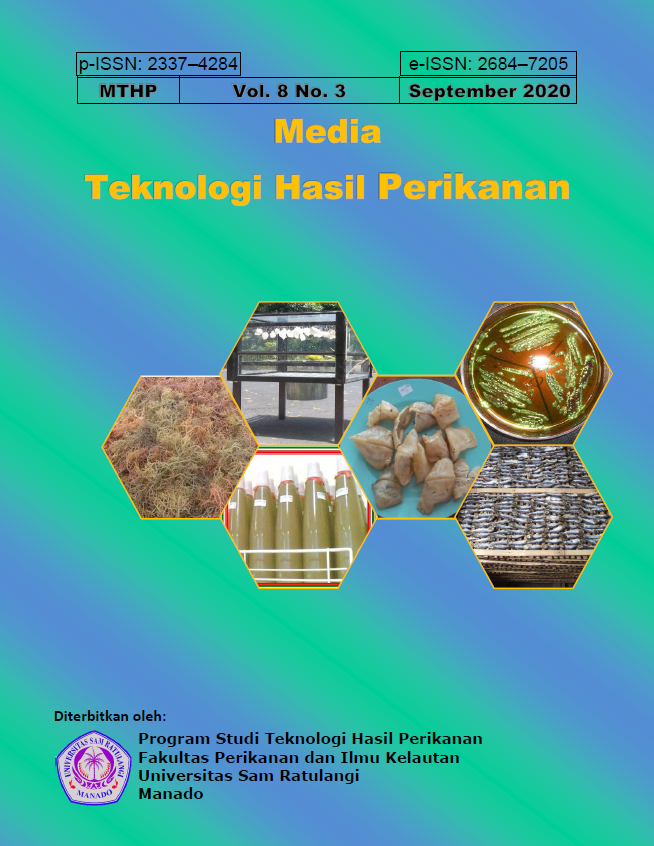Ekstraksi Kolagen Tulang Ikan Tuna (Thunnus sp) DENGAN ASAM KLORIDA
DOI:
https://doi.org/10.35800/mthp.8.3.2020.29573Keywords:
Collagen Extraction, Cloride Acid, Tuna Fish (Thunnus sp.)Abstract
Previously, commercial collagen are obtained from mammals and poultry. However, there is a huge concern about Bovine Spongiform Encephalopathy (BSE, “mad cow diseaseâ€) and avian influenza from the consumers, that is why many researcher are trying to explore the utilization of marine animals as source of collagen. The aim of this study is to gathering information about extraction collagen from Tuna (Thunnus sp.) using 1% and 3% Chloride Acid. The result indicated that the rendement was 1,42 % and 5,65 %, moisture contents 7 % and 12 %, and acidity (pH) 4,30 % and 5,19 %. These results suggested that the using 3% chloride acid in the extraction process produced higher collagen.
Â
Sebelumnya, kolagen komersial diperoleh dari mamalia dan unggas. Namun demikian, terdapat kekhawatiran yang sangat besar terhadap Bovine Spongiform Encephalopathy (BSE, “penyakit sapi gilaâ€) dan flu burung dari konsumen, oleh karena itu banyak peneliti yang mencoba untuk mengeksplorasi pemanfaatan hewan laut sebagai sumber kolagen. Tujuan dari penelitian ini adalah untuk memperoleh informasi tentang ekstraksi kolagen dari ikan tuna (Thunnus sp.) Menggunakan Asam Klorida 1% dan 3%. Hasil penelitian menunjukkan bahwa rendemen 1,42% dan 5,65%, kadar air 7% dan 12%, serta keasaman (pH) 4,30% dan 5,19%. Hasil ini menunjukkan bahwa penggunaan asam klorida 3% dalam proses ekstraksi menghasilkan kolagen yang lebih tinggi.
Â
Â
References
Alhana, Suptijah P, Tarman K. (2015). Ekstraksi dan karakterisasi kolagen dari daging teripang gamma. Jurnal Pengolahan Hasil Perikanan Indonesia. 18(2): 150-161.
AOAC. (2005). Official Method of Analysis (18th ed). Washington DC (US): The Association of Official Analytical Chemist.
BSN. (2014). Kolagen kasar dari sisik ikan- syarat mutu dan pengolahan- SNI 8076-2014. Jakarta (ID): Badan Standarisasi Nasional.
Devi HLNA, Suptijah P, Nurilmala M. (2017). Efektifitas alkali dan asam terhadap mutu kolagen dari kulit ikan patin. Jurnal Pengolahan Hasil Perikanan Indonesia. 20(2): 255-265.
Herng Wu, K., dan Huey-Jine Chai. (2007). Collagen of Fish Scale and Method of Making Thereof. Jurnal Ilmiah Internasional. Keelung City.
Jaswir I, Monsur HA, Salleh HM. (2011). Nano-structural analysis of fish collagen extracts for new process development. Africant Journal of Biotechnology. 10(81): 18847-18854.
Junianto, (2003). Teknik Penanganan Ikan. Jakarta : Penebar Swadaya.
Martin A., J. Swarbrick dan A. Cammarata, (1993). Farmasi Fisika, Edisi III, Penerjemah Yoshita. Jakarta : Universitas Indonesia Press.
Martin, A., Swarbick, J., dan A. Cammarata. (1993). Farmasi Fisik 2. Edisi III. Jakarta: UI Press. Pp. 940-1010, 1162, 1163, 1170.
Maulida, R., (2011). Ekstraksi Gelatin Dari Tulang Ikan Tenggiri dengan Variasi Konsentrasi HCl, Universitas Tanjungpura, Pontianak, (Skripsi).
Naro A.B., Sahubawa L. dan Ekantari N., (2013). Ekstraksi dan Karakterisasi Kolagen dari Kulit Ikan Nila Hitam (Oreochoromis niloticus). Jurnal Tekno Sains. Universitas Gadjah Mada Jurusan Perikanan Fakultas Pertanian. Vol 10. Hal : 172.
Singkuku T.F, Onibala H., Agustin T.A. (2017). Ekstraksi Kolagen Tulang Ikan Cakalang (Katsuwonus pelamis L.) Menjadi Gelatin Dengan Asam Klorida. Volume 5(3):163-166.
Downloads
Published
How to Cite
Issue
Section
License
Authors who publish with this journal agree to the following terms:
- Authors retain copyright and grant the journal right of first publication with the work simultaneously licensed under a Creative Commons Attribution License that allows others to share the work with an acknowledgement of the work's authorship and initial publication in this journal.
- Authors are able to enter into separate, additional contractual arrangements for the non-exclusive distribution of the journal's published version of the work (e.g., post it to an institutional repository or publish it in a book), with an acknowledgement of its initial publication in this journal.
- Authors are permitted and encouraged to post their work online (e.g., in institutional repositories or on their website) prior to and during the submission process, as it can lead to productive exchanges, as well as earlier and greater citation of published work (See The Effect of Open Access).







